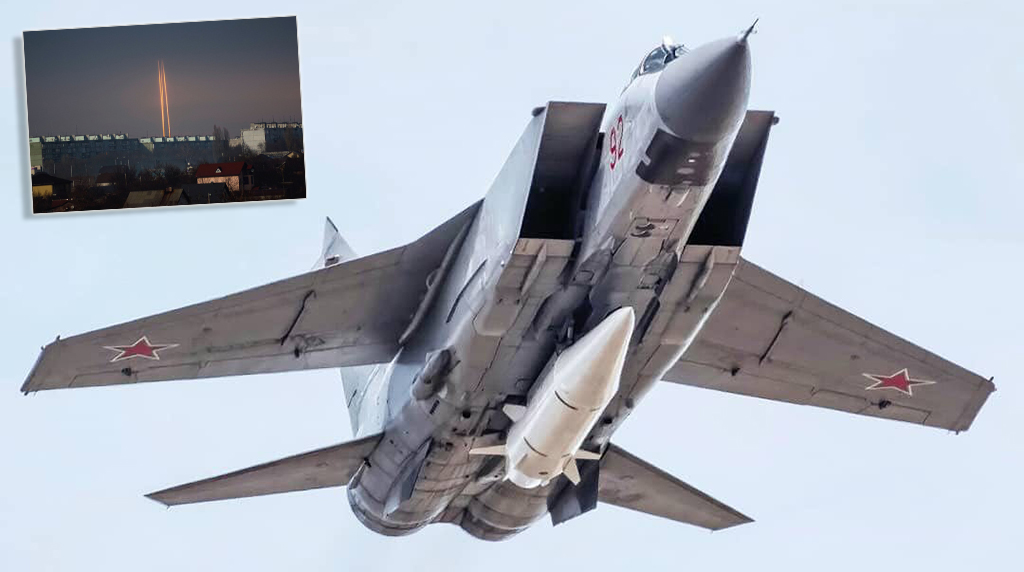More than 80 missiles as well as eight kamikaze drones hit multiple targets across Ukraine.
A massive missile attack was launched by Russia at the Ukrainian energy infrastructure and other targets across Ukraine on Mar. 9, 2023. Kyiv, Kharkiv, Sumy, Zaporizhzhia, Dnipropetrovk, Ivano-Frankivsk, Zhytomyr, Lviv and Odessa Oblasts were reportedly hit: six people were killed in the strikes and hundreds of thousands left without heat or electricity in the largest attack since Feb. 16, 2023.
According to Ukraine’s chief commander of the armed forces, Valerii Zaluzhnyi, Russia launched 81 missiles and eight Iranian-made Shahed-136/131 kamikaze drones. Among the weapons used in the massive bombardment, six Kh-47 Kinzhal hypersonic cruise missiles, 20x Kalibr sea-launched cruise missiles, 28 x Kh-101/Kh-555 air-launched cruise missiles, and 13x S-300s in surface-to-surface mode: a wide variety of munitions extremely difficult to stop.
Ukraine’s Air Force Command says Russia launched 81 missiles overnight:
– 28 x Kh-101/Kh-555 air-launched cruise
– 20 x Kalibr sea-launched cruise
– 6 x Kh-22 air-launched cruise (they’re old)
– 6 x Kh-47 Kinzhal
– 2 x Kh-31P (anti-radar)
– 6 x KH-59 (TV-guided)
– 13 x S-300 SAMs
— Chris Partridge (@Chris1603) March 9, 2023
A total of 34 missiles and four drones were intercepted, the Ukrainian Air Force said.
Remains of a Russian Kh-101 cruise missile downed by Ukrainian air defenses outside of Pryluky, Chernihiv Oblast. pic.twitter.com/Wz2TmALCO8
— OSINTtechnical (@Osinttechnical) March 9, 2023
The most surprising aspect of today’s attack is probably the use of six Kh-47M2 Kinzhal hypersonic missiles. Thus far, just a handful of attacks have been carried out using the Kinzhal missile, the first of those was more or less one year ago. As we have already reported in the past, Kinzhal is basically an air-launched Iskander-M SRBM (short-range ballistic missile) that uses a MiG-31K Foxhound or Tu-22M3 Backfire assets as an air-breathing first stage to increase its range: in fact, it is actually not a “hypersonic weapon” in the sense that it is an air-breathing missile based on scramjet technology and, as a ballistic missile, it flies at hypersonic speed with a reported cruise missile-like flat flight profile.
According to Russians and reference sources, the Kinzhal missile has a range of 1,200 miles (approximately 2,000 kilometers) and a top speed of Mach 10. Moreover, it maintains some ability to maneuver throughout its performance envelope including at hypersonic speed. If accurate, these capabilities could make the Kinzhal difficult to intercept by anti-missile systems.
The number of Kinzhal missiles Russia is able to field as well as the actual capabilities of the missile are still debated with some analysts saying that it is not as advanced as Russia claims. Is the use of the much hyped and feared hypersonic missile a sign that Russia has now sufficient stockpiles to start using them in significant numbers or, on the contrary, a sign that it is running out of stocks of other types of ammunition?
Whatever the future will be, today’s attack shows Moscow is able to fire volleys of Kinzhal missiles with the Ukrainian air defense systems unable to stop any of them.
According to the Ukrainian Air Force along with the six Kinzhal-carrier MiG-31K fighter jets, the missile barrage was launched by ten Tu-95 strategic bombers, seven Tu-22M3 long-range bombers, eight Su-35 multi-role fighter jets, and three Kalibr cruise missile carriers in the Black Sea.
The attack also caused a power loss at the Zaporizhzhia nuclear plant, the largest in Europe. Since the nuclear reactors need constant power to run cooling systems to avoid a meltdown, the power loss, that lasted nearly half of the day, caused widespread concern of a potential nuclear catastrophe.













